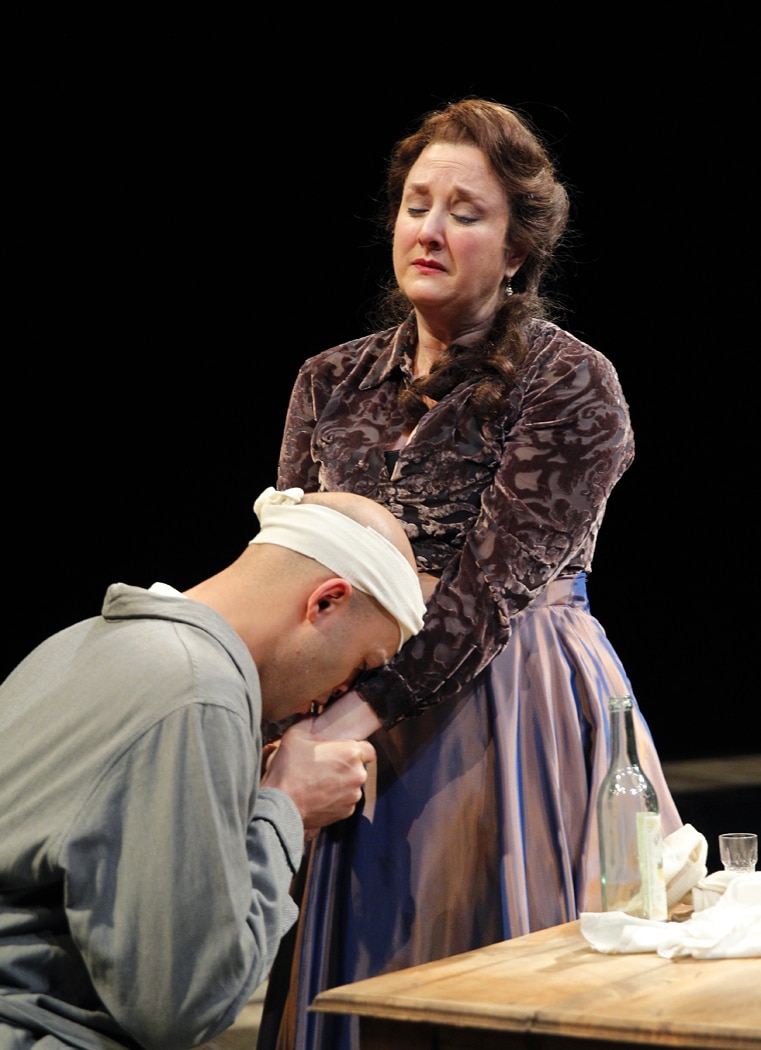Julie Briskman is no stranger to ACT’s stages and to Seattle audiences. The versatile artist returns as Linda in Lucas Hnath’s The Thin Place.
We asked Julie about her role in The Thin Place and much more.
You have a brilliant career working with rich characters and classical pieces and playwrights, like Chekhov, Wilde and Shakespeare. Lucas Hnath’s writing is very contemporary. The way the play sits on the page is very different. How have you interacted with this very modern text? How was the experience with The Thin Place script in relation to the work you’ve encountered in the past?
Yes! That is something you notice right away reading this play, the way it’s laid out on the page.
As an actor, you always begin with the word. I am there to serve the playwright first and foremost. The gift Lucas has given us, is an insight into his vision for how this play moves. With any good play, what happens between the lines, is as important as what’s being said, and because I had no idea what this play was about when I was asked to audition, I was reading it truly cold. So, the way he crafts the text on the page is not only very specific, it also added to the urgency of the story, and my being enveloped in a sense of WHAT IS HAPPENING?! And that is how I felt every time I read it. There is an urgency that is wound very tight. It was thrilling to read every time, and I never felt myself get ahead of the story. That is something as actors we are often reminded of: don’t let the audience get ahead of you. Trust them, they’ll keep up. It has to do with the pace and the rhythm and the heartbeat of how we’re telling the story. The fact that Lucas has created this on the page, is fantastic.
Why should audiences see The Thin Place?
Oh! Audiences should see The Thin Place because as Linda might say, “They’ll have a ruddy good time!”
Is there something you hope audiences take away from the play?
As for what I hope they take away from this play, I can’t answer that. As Chekhov said, the role of the artist is to ask questions, not to answer them.
We do what we do as actors, and we never know what someone will take away on any given night, how it might affect or change them. Whether this piece will be one that stays with them for a long time, or just lingers for the car ride home. If I have a hope, for any play I’m a part of, it’s that you are moved in some way, that something shifts. Maybe you feel altered on a cellular level, or maybe that’s the first time you’ve let out a deep breath in a really long time. Perhaps your world view is rocked, or maybe you had a wonderful entertaining night at the theater. To me, it’s all good, as long as it’s something.
What do you love most about Linda?
I love how direct Linda is.
I love that she’s from a working-class neighborhood in Yorkshire.
I love that the playwright describes her in the simplest of terms, which means I can feel completely free in what I am bringing to her.
I love that there will be different opinions from the audience about who she is.
I love that I am doing this play at ACT with this group of artists.
You’ve been on ACT’s stage many times. What do you enjoy about ACT? What keeps you coming back?
Yes, I have been on ACT’s stages many times, and it always feels like home. From my first show here in 2002, which was Dirty Blonde, to Absurd Person Singular, to Enchanted April to The Lady with All the Answers to The Underpants, to The Women, to the Pinter Festival and many more, and then becoming an ACT Lab producing partner with The Seagull Project, I have been beyond fortunate for the opportunities I’ve had here. It’s wonderful to come out of COVID, and to be back at ACT with everyone in this building, along with the audiences we love so much.
Chocolate or wine?
Well, that’s like asking puppies or kittens to which I say BOTH thank you! Also, bunnies.
Finally, how do you feel coming back to the building and breathing life into characters in front of a live audience?
I have always been so grateful to be an actor, and that gratitude is even more pointed now. I do not take lightly all that has been done in the community and by the theaters themselves to stay up and running, to keep existing during such a challenging time in all our lives.
It has taken bravery on everyone’s part to keep creating, for audiences to come back, for believing that what we create together is vital. Living without live art for two years reinforced how deeply we need to create something bigger than ourselves and share the experience of that together. To breathe each other’s air.
Here’s to all of us being together again, in the same space, and in the words of Chekhov: creating boldly, with full consciousness and beauty.
Featured Photo Caption: Julie Briskman and Brandon J. Simmons as Arkadina and Treplev in The Seagull. Produced by The Seagull Project in partnership with ACTLab. Photo by Chris Bennion.

